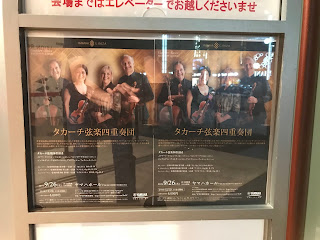Takács Quartet at Yamaha Hall, September 26th 2019
Only one founding member remains, cellist András Fejér. First violinist Edward Dusinberre joined in 1993 and violist Geraldine Walther in 2005. The most recent addition is second violinist Harumi Rhodes who joined last year. And yet the name Takács Quartet carries a lot of weight, it’s considered one of the leading chamber music ensembles in the world. Recordings like that of the Bartók cycle, from 1993, are a point of reference among fans.
This concert took place at the Yamaha Hall, a posh concert hall with excellent acoustics nested on the eight floor of the Yamaha building in Ginza. It started right on time with Haydn’s Quartet OP. 33 No. 3, “The Bird”. These one, along with the other five quartets in Opus 33, was dedicated to the Grand Duke Paul of Russia, who will eventually will be crowned as emperor and will reign the country for five years at the end of the 18th Century. As the nickname hints it, there’s a feathery lightness to this piece that was eloquently conveyed by the members of Takács. Joseph Haydn is considered the father of the string quartet form as we know it today. What was different then compared to what it is now, was the idea of the concert. Most performances were in private quarters and the publishing of this pieces targeted families, groups of musicians who will gather to perform these pieces for their own amusement. That sense of playfulness was definitely captured in this performance.
Before the 20 minutes intermission, another steppingstone of the genre was performed. Antonín Dvořák s String Quartet No. 12 “The American”. It was written while on vacation in Iowa, Dvořák lived three years in the United States. According to the composer, this melodic work was inspired by Haydn and, in spite of his nickname, it doesn’t really quote any kind of American folk music. It’s been said that Dvořák was an admirer of the spirituals, some of that admiration probably found its way to the piece. It blows the mind to think how much of this music shaped what we now think the Old West sounded, from movies, etc. I was reminded of a concept I studied in university: Saussure’s idea of the arbitrariness of the sign. How there’s no correlation between the form of the sign and its meaning. In this particular piece, written in 1893, between the lack of clear American influences and how it became the ideal soundtrack of the west, copied in the music of hundreds of westerns. From the opening theme, introduced by the viola, until its powerful finale, the Takács Quartet accurately and masterfully translated the dynamism and energy of this masterpiece.
Another masterpiece awaited for us after the intermission, this time from none other than Ludwig Van Beethoven, whose 250th birth anniversary will be celebrated next year. Like Haydn’s quartet, Beethoven’s String Quartet No. 9 was dedicated to a Russian noble, the ambassador in Vienna count Andreas Razumovsky, who commissioned the set of three quartets in Opus 59. According to Jan Swafford in his biography Beethoven Anguish and Triumph, it was this set of string quartets that gave Beethoven the confidence to push the limits of the form and in the public eye liberated him from the shadow of Haydn and Mozart in regards of this particular musical configuration. It was written in a very fruitful 1806, a year that saw the completion of his opera Fidelio, the Fourth Symphony and the Violin Concerto. The exploration of new territory can be perceived with its ethereal opening in Andante with single notes at unison that builds up to the first theme in Allegro. The 35 minutes performance was as crisp as in the recordings and never failed to command the audience’s attention, who at the end rewarded the group with a vigorous and spontaneous ovation.
After a few vows and some words in Japanese read by the newest member, they played the Intermezzo from Mendelssohn’s String Quartet No. 2. The first violin delicate melody punctuated by the pizzicato accompaniment plucked by the rest of the instruments was a perfect ending for an evening in which the audience bear witness to the electrifying chemistry, professionalism and sensibility of the Takács Quartet.
Thank you for reading. Please follow me on Twitter for updates at @ConcertTokyo. You can also click the Like button and get notifications at The Tokyo Concert Experience on Facebook.





Comments
Post a Comment